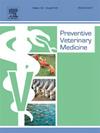Prediction of ketosis using radial basis function neural network in dairy cattle farming
IF 2.2
2区 农林科学
Q1 VETERINARY SCIENCES
引用次数: 0
Abstract
The purpose of the paper was to apply an Artificial Neural Networks with Radial Basis Function to develop an application model for diagnosing a subclinical ketosis type I and II in dairy cattle. While building the neural network model, applied methodology was compatible to the procedures used in Data Mining processes. The data set was created based on the composition of milk samples of 1520 Polish Holstein-Friesian cows. The milk samples were collected during test-day milkings and made available by Polish Federation of Cattle Breeders and Milk Producers. The milk composition parameters were used as the input variables for RBF network models. The value of the output variable was determined based on the content of β-hydroxybutyric acid in blood of cows. In the next stage of the work, the qualities of the pre-selected models were compared and the best ones were chosen. The sensitivity and specificity as well as the size of the AUC (Area Under the Curve) under the ROC (Receiver Operating Characteristic) were taken as the main criteria for network models evaluation. The model characterized by sensitivity of 0.86, specificity of 0.71 and AUC of 0.89 was selected for ketosis type I. The optimal for ketosis type II showed the sensitivity and specificity 0.81 and 0.75, respectively, and the size of AUC above 0.85. Chosen models were recorded using the predictive modelling markup language (PMML) for data mining models to be shared and used between the different applications.
基于径向基函数神经网络的奶牛酮症预测。
本文旨在应用径向基函数人工神经网络建立奶牛亚临床酮病I型和II型诊断的应用模型。在构建神经网络模型的过程中,所采用的方法与数据挖掘过程中使用的程序相适应。该数据集是基于1520头波兰荷尔斯泰因-弗里西亚奶牛的牛奶样本组成而创建的。牛奶样品是在测试日挤奶期间收集的,并由波兰牛饲养者和牛奶生产者联合会提供。将牛奶成分参数作为RBF网络模型的输入变量。根据奶牛血液中β-羟基丁酸的含量确定输出变量的值。在下一阶段的工作中,对预选模型的质量进行比较,选出最好的模型。以受试者工作特征(ROC)下曲线下面积(AUC)的大小、敏感性和特异性作为评价网络模型的主要标准。对于酮症i型,选择敏感性为0.86,特异性为0.71,AUC为0.89的模型。对于酮症II型,最优模型的敏感性和特异性分别为0.81和0.75,AUC大小在0.85以上。使用预测建模标记语言(PMML)记录所选模型,以便在不同应用程序之间共享和使用数据挖掘模型。
本文章由计算机程序翻译,如有差异,请以英文原文为准。
求助全文
约1分钟内获得全文
求助全文
来源期刊

Preventive veterinary medicine
农林科学-兽医学
CiteScore
5.60
自引率
7.70%
发文量
184
审稿时长
3 months
期刊介绍:
Preventive Veterinary Medicine is one of the leading international resources for scientific reports on animal health programs and preventive veterinary medicine. The journal follows the guidelines for standardizing and strengthening the reporting of biomedical research which are available from the CONSORT, MOOSE, PRISMA, REFLECT, STARD, and STROBE statements. The journal focuses on:
Epidemiology of health events relevant to domestic and wild animals;
Economic impacts of epidemic and endemic animal and zoonotic diseases;
Latest methods and approaches in veterinary epidemiology;
Disease and infection control or eradication measures;
The "One Health" concept and the relationships between veterinary medicine, human health, animal-production systems, and the environment;
Development of new techniques in surveillance systems and diagnosis;
Evaluation and control of diseases in animal populations.
 求助内容:
求助内容: 应助结果提醒方式:
应助结果提醒方式:


